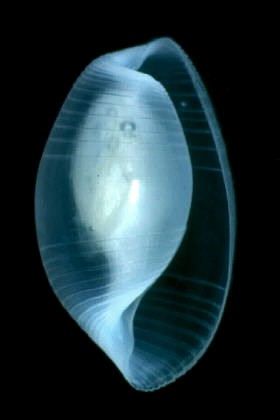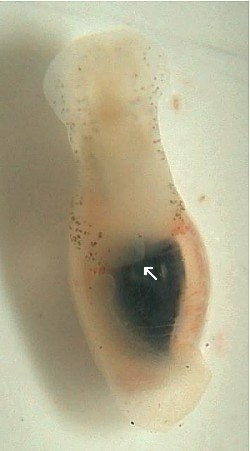

Atys semistriata
Pease, 1860
Order: CEPHALASPIDEA
Superfamily: HAMINOEOIDEA
Family: Haminoeidae
PHOTO
under a coral slab on the hard reef flat in front of Afono village, north Tutuila Island, American Samoa, 20 May 2000. PHOTO: Don Barclay.
LOWER: Shell of 8mm long animal; shell 6.1 x 3.5mm; Piti Bomb Hole, Guam: 19 July 1995. Coll. by John Starmer. PHOTO: C. Carlson.
"Atys semistriata appears to have a fairly wide Western Pacific distribution. We have photos from Atsushi Ono that probably represent this species as well as material from Indonesia. The red color can be very sparse or be present on almost all of the mantle. Various degrees of dark specking can be found on the headshield and parapodia. The Hancock's Organs differ from the ribbon like forms we see in most haminoeids. In A. semistriata they appear to be a line of papilla or platelets along the side of the head into the neck area. These organs in Guam animals are yellow. A. semistriata is most commonly found at night on algae covered material. During the day they can be occasionally found under rocks or coral rubble." .... C.Carlson & P.J.Hoff.
For further photos see message below.
Reference:
• Pease, W.H. (1860) Descriptions of new species of mollusca from the Sandwich Islands. Proceedings of the Zoological Society of London, 28: 18-36.
Rudman, W.B., 2000 (May 24) Atys semistriata Pease, 1860. [In] Sea Slug Forum. Australian Museum, Sydney. Available from http://www.seaslugforum.net/find/atyssemi
Related messages
Atys semistriata from Samoa
June 4, 2000
From: C.Carlson & P.J.Hoff

Bill,
The haminoeid from Don Barclay (20 May) is probably Atys semistriata Pease, 1860. This species appears to have a fairly wide Western Pacific distribution. We have photos from Atsushi Ono that probably represent this species as well as material from Indonesia. The red color can be very sparse or be present on almost all of the mantle. Various degrees of dark specking can be found on the headshield and parapodia. The Hancock's
Organs differ from the ribbon like forms we see in most haminoeids. In A. semistriata they appear to be a line of papilla or platelets along the side of the head into the neck area. These organs in Guam animals are yellow. The dorsal view of the Samoan animal appears to show some color
on the left side where the organs on that side would be. A. semistriata is most commonly found at night on algae covered material. During the day they can be occasionally found under rocks or coral rubble.
I've enclosed a scan showing that this animal is a 'true' bubble shell.
Specimen data: 8mm; shell 6.1 x 3.5mm; Guam, Piti Bomb Hole; 19 July 1995. Coll. by John Starmer.
Clay & Patty Jo.
Merizo, Guam
clay.carlson@kuentos.guam.net
Carlson, C. & Hoff, P.J., 2000 (Jun 4) Atys semistriata from Samoa. [Message in] Sea Slug Forum. Australian Museum, Sydney. Available from http://www.seaslugforum.net/find/2491Dear Clay & Patty Jo,
Thanks for the identification and photo. For those of you unfamiliar with bubble shell anatomy the Hancocks Organs are a special sensory organ found in Cephalaspideans which senses chemicals in the water. It is their organ of 'smell', equivalent to the rhinophores of the nudibranchs. It consists of a patch on each side of the head in the groove between the head shield and the foot. It is usually a relatively smooth yellow to brown patch but in some species like Hydatina physis it is a prominent organ consisting of large gill-like leaflets. When I get a moment I will prepare a page on this organ.
Best wishes,
Bill Rudman.
Another Samoan haminoeid
May 25, 2000
From: Don Barclay

Hi Bill,
Here's another one for you and Clay. This little haminoeid was collected around 1500 local (low tide), 20 May 2000 under a coral slab on the hard reef flat in front of Afono village, north Tutuila Island, American Samoa. Water was about one meter deep, and there was none of the filamentous algae in this area that has been associated with the other Haminoea species that I've found here. However, I did find a small Marginella under the same slab, similar to the Marginella species that I usually find in the other Haminoea areas, but I believe it is a different species. The bottom of the slab was covered with sponge growth and other life, including several Philbertia species, two Pyrene species, a few triphorids and a single Cypraea isabella.
The shell measures 4.1 x 2.3mm, is more elongate than the Haminoea cf. ovalis I've found here, and even has some sculpture (visible in the photos). It appears to belong to Clay Carlson's "orange-spotted" group. Any ideas?
Thanks a lot,
Don
n5ols@samoatelco.com


Dear Don,
Your animal is in the same family as Haminoea but I think it is a species of Atys or one of the other similar genera. It looks quite like Atys cylindrica but I think it is a distinct species. It looks quite like Limulatys ooformis Habe, 1952. Hopefully Clay Carlson can give us some advice.
Your photo (lower right) showing the underside (ventral side) of the animal shows how the foot in most haminoeids is very short, rarely extending back under the shell. I have marked the posterior end of the foot with an arrow. In haminoeids a flap of mantle tissue extends out of the mantle to form a secondary foot. It is only slightly enlarged in this species, but in many species, it is much larger and from above, animals such as Haminoea seem to have a large foot extending from the head to beyond the posterior end of the foot.
Best wishes,
Bill Rudman.
